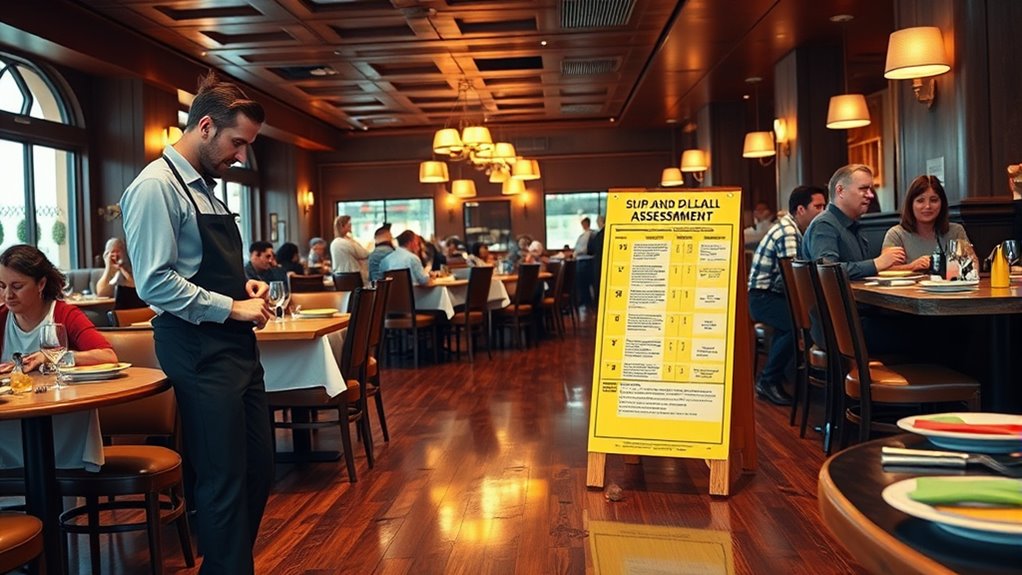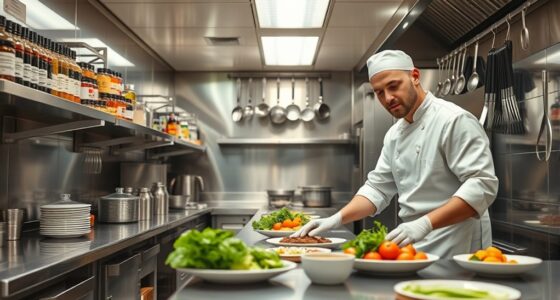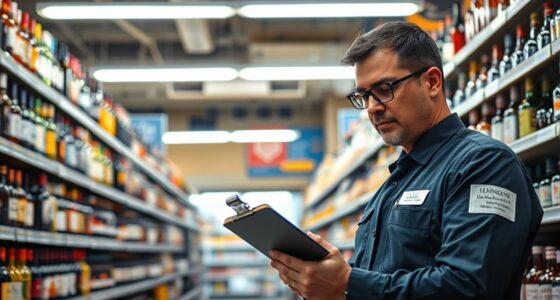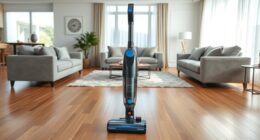To conduct slip-and-fall risk assessments in dining areas, start by systematically inspecting all surfaces, focusing on spills, uneven flooring, and cluttered walkways. Check lighting and signage to guarantee visibility and warnings are clear. Repair damaged floors, secure rugs, and install non-slip mats where needed. Train staff to recognize hazards quickly and enforce safety protocols like immediate spill cleanup. Continuing with these steps helps you maintain a safer environment—there’s more to learn for thorough prevention.
Key Takeaways
- Conduct systematic walk-through inspections of all dining areas, focusing on potential slip hazards like spills, clutter, and uneven surfaces.
- Use checklists to identify and document hazards such as wet floors, loose rugs, or damaged flooring promptly.
- Assess lighting conditions and signage to ensure hazards are visible and warnings are clearly communicated.
- Implement immediate corrective actions like cleaning spills, repairing flooring, and securing rugs to prevent falls.
- Train staff to recognize slip hazards, report risks promptly, and follow safety protocols for hazard mitigation.
Identifying Common Hazards in Restaurant Settings
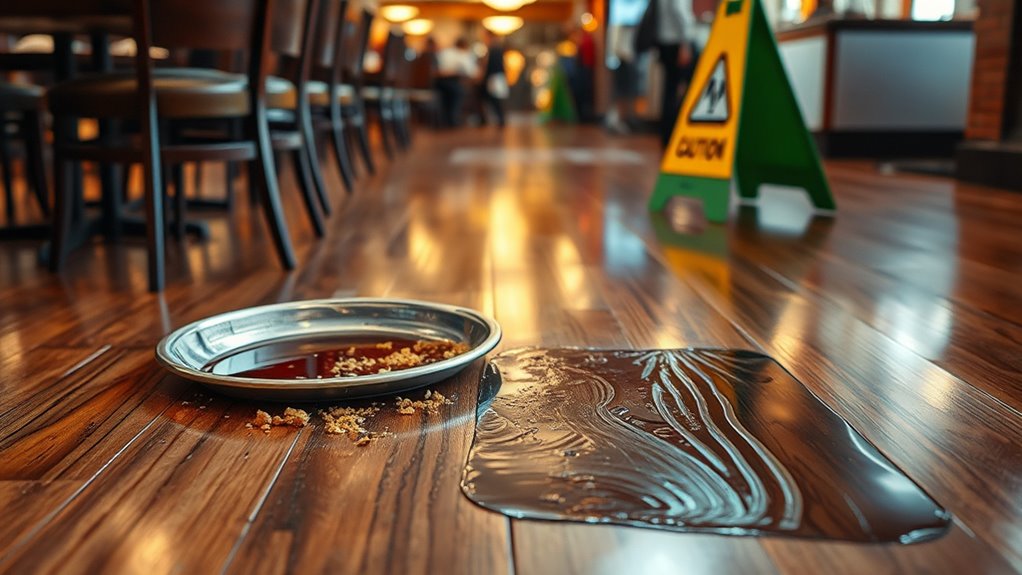
In restaurant settings, hazards that can lead to slips and falls are often hidden in plain sight. You need to be alert to spilled liquids that may go unnoticed, especially near tables or walkways. Loose rugs or mats can bunch up, creating tripping hazards. Uneven flooring, such as cracked tiles or warped surfaces, also increases risks. Cluttered walkways with misplaced chairs, carts, or supplies can obstruct safe movement. Additionally, water or grease buildup on floors from cleaning or food prep can be slick and dangerous. Recognizing these common hazards allows you to address them quickly, minimizing the risk of accidents. Regularly inspecting the environment ensures hazards don’t go unnoticed, keeping both staff and guests safe from slip-and-fall incidents. Online platforms provide helpful resources for conducting thorough risk assessments and staying updated on safety best practices.
Conducting Effective Walk-Through Inspections
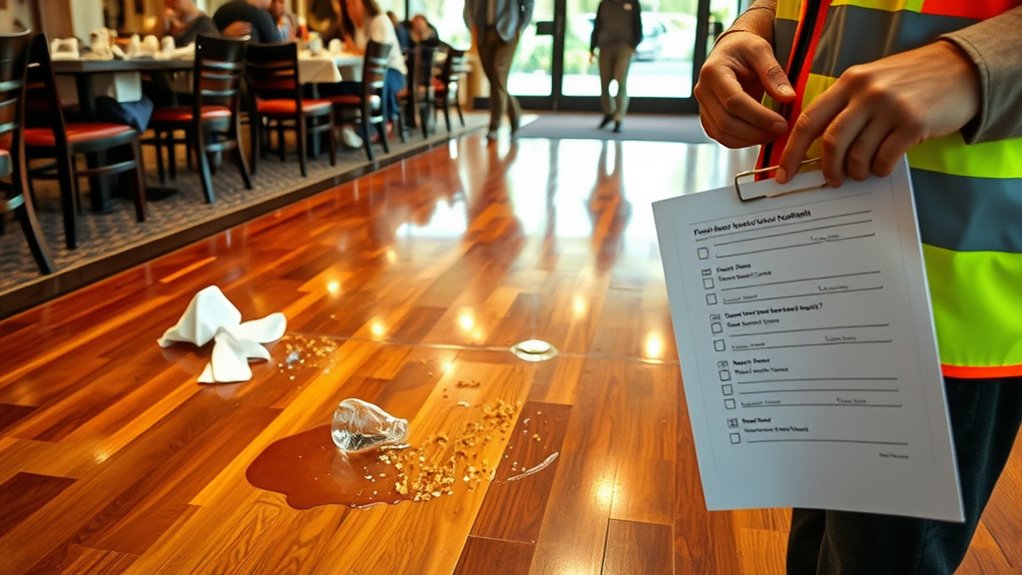
Conducting a thorough walk-through inspection is a vital step in maintaining a safe dining environment. As you perform the inspection, focus on systematically covering all areas, from the entrance to the kitchen and restrooms. Look for obvious hazards like spills, clutter, or uneven surfaces that could cause slips. Use a checklist to guarantee you don’t overlook key points, such as lighting conditions and signage. Pay attention to the condition of flooring, handrails, and mats, noting any signs of damage or wear. Engage staff during your walk, encouraging them to report concerns. Take notes and photos where necessary for documentation. Regular inspections help you identify risks early, allowing prompt corrective actions to prevent slip-and-fall incidents. Recognizing the importance of preventive measures can significantly reduce the likelihood of accidents.
Evaluating Flooring and Surface Conditions
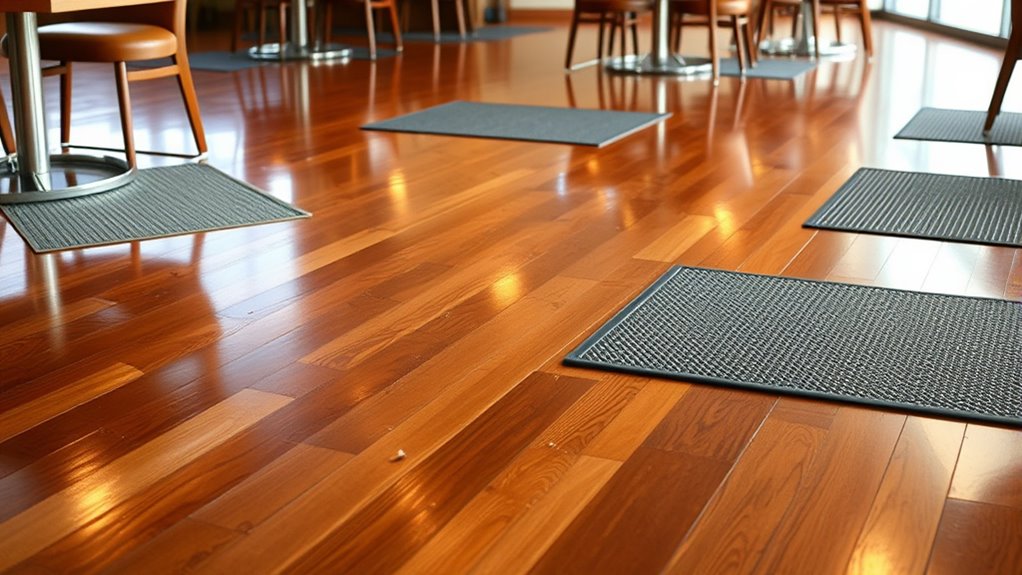
Evaluating flooring and surface conditions is essential for preventing slip-and-fall accidents in dining areas. You should look for cracks, uneven patches, or worn-out surfaces that can cause trips or slips. Check for any spills, debris, or wet spots that haven’t dried properly. Pay close attention to high-traffic zones, entrances, and near kitchen areas where surfaces are more likely to be compromised. Assess the texture of the flooring—surfaces should provide enough grip without being overly rough. Also, verify that mats and rugs are secure and free of wrinkles or loose edges. Regular inspections help identify hazards early, reducing the risk of accidents. By maintaining and promptly addressing surface issues, you create a safer environment for everyone. Additionally, pet-friendly policies can influence the cleanliness and safety of dining surfaces, making it important to consider how pets are accommodated within the space.
Implementing Preventative Measures and Safety Protocols
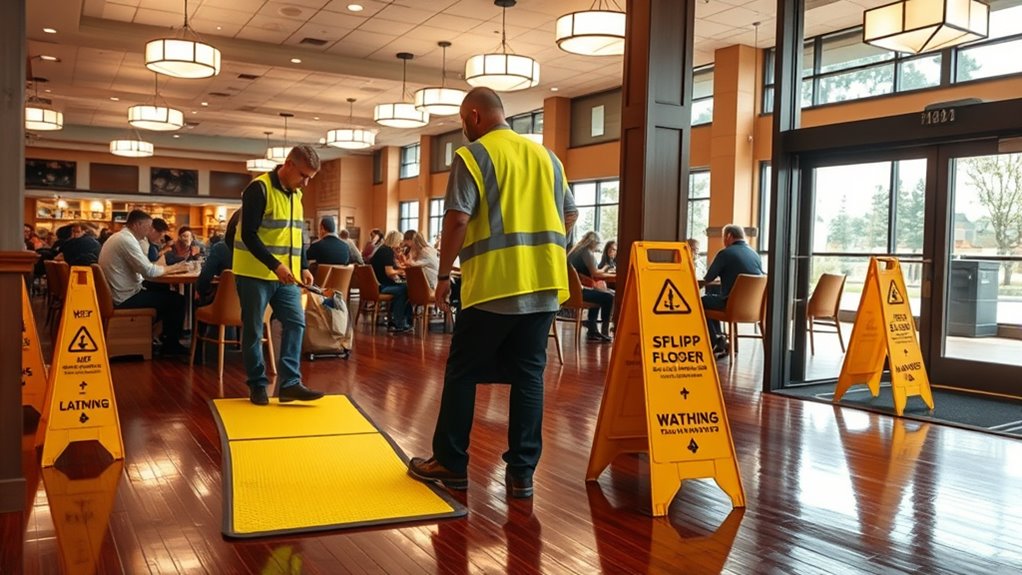
Implementing preventative measures and safety protocols is essential for reducing slip-and-fall risks in dining areas. Start by ensuring all spills are cleaned immediately and wet floor signs are used consistently. Regularly inspect flooring for damage, wear, or loose tiles, and repair them promptly. Install non-slip mats in high-traffic or wet zones to provide extra traction. Maintain good lighting to clearly illuminate potential hazards. Encourage staff to keep walkways clear of obstacles like carts or furniture that could cause trips. Establish clear procedures for reporting hazards so issues are addressed before accidents happen. Conduct slip-and-fall risk assessments periodically to identify new hazards and update safety measures accordingly. By proactively applying these measures and enforcing safety protocols, you create a safer environment that minimizes slip-and-fall incidents, protecting both your guests and your reputation.
Training Staff to Recognize and Address Risks
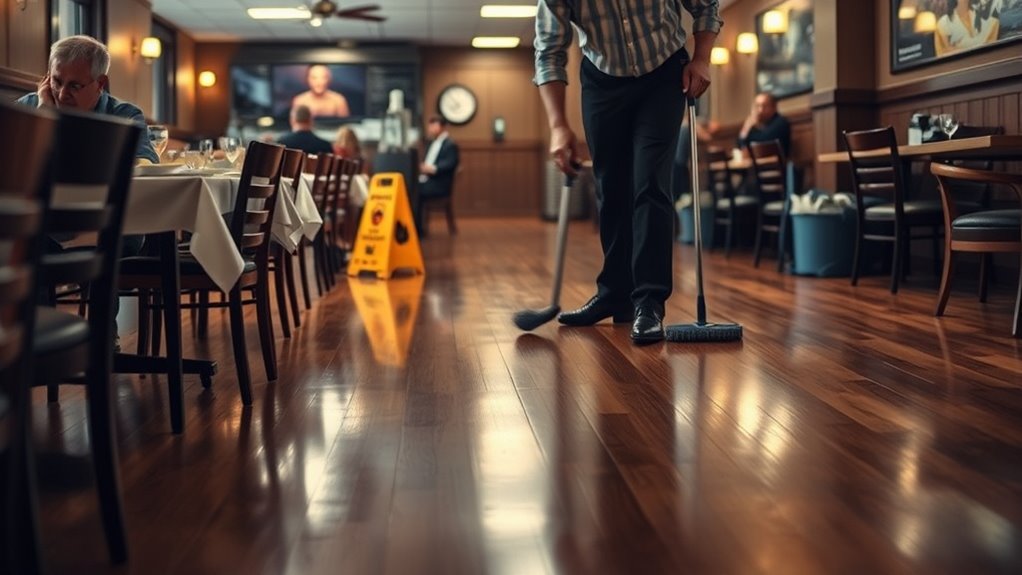
Training staff to recognize and address risks is a vital step in maintaining a safe dining environment. You need to guarantee your team knows what hazards to look for, such as wet floors, clutter, or uneven surfaces. Conduct regular training sessions that focus on identifying potential slip hazards quickly. Teach staff to be proactive by inspecting dining areas frequently and addressing issues immediately. Empower your team to report hazards without hesitation, and establish clear procedures for cleaning spills or repairing damaged flooring. Consistent training keeps everyone alert and responsible, reducing the likelihood of accidents. Remember, well-informed staff not only prevent slips but also create a safety-conscious atmosphere for both customers and employees. Incorporating somatic awareness techniques can further enhance staff responsiveness to physical hazards and promote overall safety.
Frequently Asked Questions
How Often Should Slip-And-Fall Risk Assessments Be Updated?
You should update slip-and-fall risk assessments regularly to keep your safety measures effective. Typically, it’s recommended to review them at least every six months or whenever there are significant changes in the environment, such as new flooring or furniture. Additionally, after any incident or near-miss, you should reassess the risks immediately. Staying proactive helps you identify hazards early and maintain a safe dining area for everyone.
What Specific Tools Are Recommended for Conducting Risk Evaluations?
You should use tools like checklists, hazard mapping, and safety audit forms for conducting risk evaluations. These tools help you systematically identify potential hazards, assess their severity, and prioritize corrective actions. Additionally, consider using smartphone apps or digital forms to streamline the process and verify thorough documentation. Regularly updating these tools based on new hazards or changes in your environment keeps your evaluations accurate and effective.
How Can Lighting Impact Slip-And-Fall Risks in Dining Areas?
Did you know poor lighting causes about 20% of slip-and-fall accidents? In dining areas, lighting plays an essential role in safety. When you make certain of proper, bright, and even lighting, you help guests see hazards clearly, reducing the risk of slips and falls. You can prevent accidents by regularly checking light fixtures, replacing dim bulbs, and eliminating shadows, creating a safer environment for everyone.
Are There Legal Requirements for Documenting Safety Inspections?
You need to understand that legal requirements for documenting safety inspections vary by jurisdiction, but generally, you’re expected to keep detailed records of inspections, hazards identified, and corrective actions taken. You should regularly review and update these documents to demonstrate compliance and protect yourself legally. Failure to document safety checks can result in penalties or liability if an accident occurs, so it’s vital to maintain thorough, accurate records consistently.
How Do Weather Conditions Influence Slip-And-Fall Hazards Indoors?
Weather conditions can turn your indoor dining area into a slip-and-fall nightmare, like a skating rink overnight. When it’s rainy or snowy outside, moisture gets tracked inside on shoes, mats, or floors, creating slick surfaces. You might not see the danger until someone slips, risking serious injury. Regular cleaning, prompt spill and moisture management, and proper mats help minimize these hazards, keeping your space safe regardless of the weather outside.
Conclusion
By staying vigilant and regularly inspecting your dining area, you can spot hazards before they cause harm. Think of your safety checks as the steady heartbeat of a well-run restaurant—crucial and consistent. When you train your staff and implement preventive measures, you create a safer environment for everyone. Remember, a slip is like a thief in the night; it can strike unexpectedly. Stay prepared, stay proactive, and keep your guests safe.
